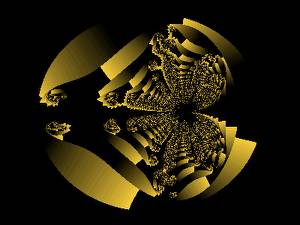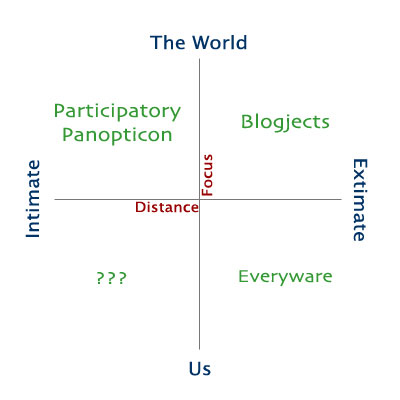Everyware, Blogjects and the Participatory Panopticon
 I love to watch the future take shape.
I love to watch the future take shape.
For the past few years, I've closely watched the emergence of a set of technologies that make possible constant, widespread, and inexpensive observation and annotation of ourselves and the world. Cheap processors, low-power sensors, and ubiquitous wireless networks are critical elements of a scenario in which we can more readily know and, in the better versions, access the world around us. The key drivers for this emergence are our need to connect with each other and, increasingly, our need to monitor the changes taking place to our environment.
The version of this world that I've followed most closely is what I've called the "participatory panopticon" -- a scenario in which our personal mobile devices watch the world around us, acting both as a back-up memory and as a medium for the capture of our experiences of the world. These are intimate devices, carried by or worn on ourselves, made to serve as adjuncts to our own capacity to observe the space around us. The political version of the participatory panopticon (hereafter PP -- and I know, the need to abbreviate it is a sign that this isn't the right language for the concept) has been around longest, in the form of "sousveillance;" the digital Witness project is its latest example. At the TED 2006 conference, I described an imagined environmental version of the PP, monitoring not social behavior but ecological conditions. The PP could take on numerous forms, but all with the same core element: the technology is an interface between ourselves and the world that focuses on what's around us.
USC's Julian Bleecker, in A Manifesto for Networked Objects — Cohabiting with Pigeons, Arphids and Aibos in the Internet of Things, describes a clearly related but not identical manifestation of this technology. He refers to them as "blogjects," objects that create an ever-expanding record of themselves, accessible over the net -- objects that tell their own stories.
[Blogjects tell us] about their conditions of manufacture, including labor contexts, costs and profit margins; materials used and consumed in the manufacturing process; patent trackbacks; and, perhaps most significantly, rules, protocols and techniques for retiring and recycling [them].
In my WorldChanging discussion of the essay, I note that Bleecker's vision gives us something akin to an "augmented world." Like the technologies of the PP, blogjects provide an interface between ourselves and the world, focused upon the world -- except here the technologies are not intimate, but are instead extimate, spread around the environment, augmenting our sense of the world at a distance.
The third, and most recent, manifestation of this "distributed attention" technology can be found in the pages of Adam Greenfield's Everyware, subtitled "the dawning age of ubiquitous computing." Greenfield's everyware model is in some respects the polar opposite of the participatory panopticon: rather than intimate devices watching the world, Everyware posits a world of extimate devices watching each of us.
That sounds more Orwellian than I think Greenfield would intend. Although it's clear he's very concerned about the social, cultural and legal implications of devices that pay attention to our behavior, Greenfield is also able to explain why the capabilities inherent to ubiquitous computing make its arrival essentially inevitable. This isn't techno-determinism, it's (for lack of a better phrase) utility-determinism. When a technology, or behavior, or idea can let people do significantly more with less effort or cost, or do useful things they could never do in the past, the likelihood of widespread adoption of that technology/behavior/idea is increased. Reading through Greenfield's examples of proto-everyware already in use, it's easy to see just how attractive aspects of this scenario will be.
Even if getting around town were the only thing Octopus [Hong Kong's smart transit card system] could be used for, that would be useful enough. But of course that's not all you can do with it, not nearly. The cards are anonymous, as good as cash at an ever-growing number of businesses, from Starbucks to local fashion retailer Bossini. You can use Octopus at vending machines, libraries, parking lots and public swimming pools. It's quickly replacing keys, card and otherwise, as the primary means of access to a wide variety of private spaces, from apartment and office buildings to university dorms. Cards can be refilled at just about any convenience store or ATM. And, of course, you can get a mobile with Octopus functionality built right into it, ideal for a place as phone-happy as Hong Kong.
Notably, Greenfield is able to avoid both ascriptions of "good" or "evil" qualities to technology and bland assertions of technology's "neutrality." All artifacts are biased, because they embed the assumptions and priorities of their creators. Sometimes the biases are sufficiently universal or inconsequential that we don't perceive them as biases, but ask any left-handed person about living in a right-handed world and you can begin to understand how pervasive subtle bias can be.
The way I've described these three manifestations of this technology suggests a larger structure at play. Here's the inevitable four-box:

Is the technology intimate (carried or worn -- or implanted -- on ourselves) or extimate (extant in the world around us)? Is the technology focused upon us (individual humans or human behavior) or the world (everything else)? In this structure, an obvious fourth niche presents itself, devices that are both intimate and self-focused. Medical monitors are a clear candidate for this box, but I wonder if there's something else that would be a more likely fit. Is this where personal augmentation technology slots in?






Comments
"Is this where personal augmentation technology slots in?"
I don't see much difference between "medical monitors" and personal augmentation, tbh. They could be the same thing. That of course causes a kind of collapse in your chart - which btw, I would like to see as a 3D representation; perhaps as a celestial coordinate system. We then become the center of our own world and all data is relevant to each of us.
Posted by: csven | April 29, 2006 5:59 AM
distance and focus are very important, and this graph touches upon Steve Mann blog statements over here:
http://www.anonequity.org/weblog/archives/000254.php#comments
Posted by: stefanos | April 29, 2006 7:12 AM
I'm gonna respond to this in the context of the conversation in progress over at the Well.
Posted by: adam | April 29, 2006 10:24 AM
Thanks, Adam!
Posted by: Jamais Cascio | April 29, 2006 10:29 AM
Greetings, Jamais. Nice to see you're still kicking around
Posted by: Tony Fisk | May 1, 2006 12:18 AM
I'm part of a project that may be of interest to those looking at sousveillance. Its Glogger
which examines sousveillance and continuous personal capture. There's some nice sousveillance shots in the archives and discussions around the pictures:
here is a sousveillance shot/discussion and here for exaxmple
Posted by: James Fung | June 13, 2006 2:15 PM